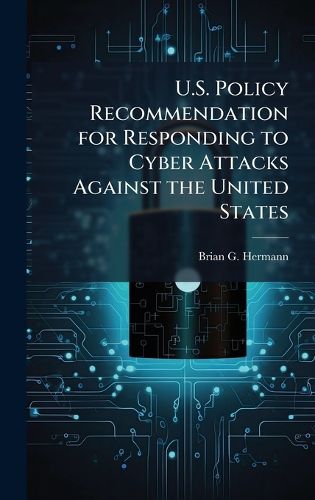Readings Newsletter
Become a Readings Member to make your shopping experience even easier.
Sign in or sign up for free!
You’re not far away from qualifying for FREE standard shipping within Australia
You’ve qualified for FREE standard shipping within Australia
The cart is loading…






U.S. Response Strategy for Cyber Attacks The United States has traditionally looked to its military to defend against all foreign enemies. International telecommunications and computer networks and globalization have now overcome the military's absolute ability to provide for that common defense. More than capable to respond to attacks in traditional war fighting domains of land, sea, air, and even space, the military will not be able to prevent all cyber attacks against U.S. interests. As a result, the U.S. should establish and announce the nature of its strategic responses to cyber attacks - including legal prosecution, diplomacy, or military action. Such a policy pronunciation will serve both as a deterrent to potential attackers and likely be established as a normative international standard. The outline for a response policy begins by addressing attacks based upon the prevailing security environment - peacetime or conflict. The U.S. should respond to peacetime attacks based on the target, reasonably expected damage, attack type, and source. Attacks likely to cause significant injuries and damage warrant a full spectrum of response options, while state-sponsored attacks would justify a forcible response when their type and target indicate destructive effects including widespread injury and damage.
This work has been selected by scholars as being culturally important, and is part of the knowledge base of civilization as we know it. This work was reproduced from the original artifact, and remains as true to the original work as possible. Therefore, you will see the original copyright references, library stamps (as most of these works have been housed in our most important libraries around the world), and other notations in the work.
This work is in the public domain in the United States of America, and possibly other nations. Within the United States, you may freely copy and distribute this work, as no entity (individual or corporate) has a copyright on the body of the work.
As a reproduction of a historical artifact, this work may contain missing or blurred pages, poor pictures, errant marks, etc. Scholars believe, and we concur, that this work is important enough to be preserved, reproduced, and made generally available to the public. We appreciate your support of the preservation process, and thank you for being an important part of keeping this knowledge alive and relevant.
$9.00 standard shipping within Australia
FREE standard shipping within Australia for orders over $100.00
Express & International shipping calculated at checkout
U.S. Response Strategy for Cyber Attacks The United States has traditionally looked to its military to defend against all foreign enemies. International telecommunications and computer networks and globalization have now overcome the military's absolute ability to provide for that common defense. More than capable to respond to attacks in traditional war fighting domains of land, sea, air, and even space, the military will not be able to prevent all cyber attacks against U.S. interests. As a result, the U.S. should establish and announce the nature of its strategic responses to cyber attacks - including legal prosecution, diplomacy, or military action. Such a policy pronunciation will serve both as a deterrent to potential attackers and likely be established as a normative international standard. The outline for a response policy begins by addressing attacks based upon the prevailing security environment - peacetime or conflict. The U.S. should respond to peacetime attacks based on the target, reasonably expected damage, attack type, and source. Attacks likely to cause significant injuries and damage warrant a full spectrum of response options, while state-sponsored attacks would justify a forcible response when their type and target indicate destructive effects including widespread injury and damage.
This work has been selected by scholars as being culturally important, and is part of the knowledge base of civilization as we know it. This work was reproduced from the original artifact, and remains as true to the original work as possible. Therefore, you will see the original copyright references, library stamps (as most of these works have been housed in our most important libraries around the world), and other notations in the work.
This work is in the public domain in the United States of America, and possibly other nations. Within the United States, you may freely copy and distribute this work, as no entity (individual or corporate) has a copyright on the body of the work.
As a reproduction of a historical artifact, this work may contain missing or blurred pages, poor pictures, errant marks, etc. Scholars believe, and we concur, that this work is important enough to be preserved, reproduced, and made generally available to the public. We appreciate your support of the preservation process, and thank you for being an important part of keeping this knowledge alive and relevant.